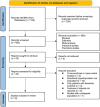Subclinical hyperthyroidism and the risk of dementia: A meta-analysis
- PMID: 39295103
- PMCID: PMC11410877
- DOI: 10.1002/brb3.70037
Subclinical hyperthyroidism and the risk of dementia: A meta-analysis
Abstract
Background: Accumulating evidence suggests that thyroid dysfunction may be related to the risk of dementia. However, previous studies evaluating the association between subclinical hyperthyroidism and the risk of dementia showed inconsistent results. This systematic review and meta-analysis were performed to evaluate the relationship between subclinical hyperthyroidism and the incidence of dementia in the general population.
Methods: Cohort studies relevant were retrieved by searching the electronic databases including PubMed, Web of Science, and Embase. A random-effects model was used to combine the data by incorporating the influence of between-study heterogeneity. Subgroup and meta-regression analyses were performed to investigate the source of heterogeneity.
Results: Nine cohort studies including 49,218 community-derived participants were included. Among them, 3177 (6.5%) had subclinical hyperthyroidism at baseline. During a mean follow-up of 10.2 years, 4044 participants developed dementia. The pooled results showed that compared to the participants with euthyroidism, those with subclinical hyperthyroidism had a higher incidence of dementia (risk ratio: 1.38, 95% confidence interval: 1.09 to 1.74, p = .006; I2 = 47%). Subgroup analyses according to study design, age of the participants, methods for diagnosis of dementia, or analytic model did not significantly change the results. The univariate meta-regression showed that the cutoff of thyroid-stimulating hormone for defining subclinical hyperthyroidism negatively affected the association between subclinical hyperthyroidism and dementia (coefficient: -1.44, p = .009), which completely explained the heterogeneity (residual I2 = 0%).
Conclusion: Subjects with subclinical hyperthyroidism may have a higher risk of dementia compared to those with euthyroidism.
Keywords: dementia; meta‐analysis; risk factor; subclinical hyperthyroidism; thyroid function.
© 2024 The Author(s). Brain and Behavior published by Wiley Periodicals LLC.
Conflict of interest statement
The authors declare that they have no conflict of interest.
Figures






Similar articles
-
Association of Thyroid Dysfunction With Cognitive Function: An Individual Participant Data Analysis.JAMA Intern Med. 2021 Nov 1;181(11):1440-1450. doi: 10.1001/jamainternmed.2021.5078. JAMA Intern Med. 2021. PMID: 34491268 Free PMC article.
-
The association between subclinical thyroid dysfunction and dementia: The Health, Aging and Body Composition (Health ABC) Study.Clin Endocrinol (Oxf). 2017 Nov;87(5):617-626. doi: 10.1111/cen.13458. Epub 2017 Sep 14. Clin Endocrinol (Oxf). 2017. PMID: 28850708 Free PMC article.
-
Subclinical Thyroid Dysfunction and the Risk of Cognitive Decline: a Meta-Analysis of Prospective Cohort Studies.J Clin Endocrinol Metab. 2016 Dec;101(12):4945-4954. doi: 10.1210/jc.2016-2129. Epub 2016 Sep 30. J Clin Endocrinol Metab. 2016. PMID: 27689250 Free PMC article. Review.
-
Association between subclinical thyroid dysfunction and depressive symptoms in the Korean adult population: The 2014 Korea National Health and Nutrition Examination Survey.PLoS One. 2018 Aug 14;13(8):e0202258. doi: 10.1371/journal.pone.0202258. eCollection 2018. PLoS One. 2018. PMID: 30106989 Free PMC article.
-
Subclinical thyroid dysfunction is associated with adverse prognosis in heart failure patients with reduced ejection fraction.BMC Cardiovasc Disord. 2019 Apr 4;19(1):83. doi: 10.1186/s12872-019-1055-x. BMC Cardiovasc Disord. 2019. PMID: 30947691 Free PMC article. Review.
Cited by
-
Vitamin D Status Determines Metformin Action on Gonadotropin Levels in Postmenopausal Women with Subclinical Hyperthyroidism.Pharmaceutics. 2025 Mar 30;17(4):442. doi: 10.3390/pharmaceutics17040442. Pharmaceutics. 2025. PMID: 40284437 Free PMC article.
References
-
- Aubert, C. E. , Bauer, D. C. , da Costa, B. R. , Feller, M. , Rieben, C. , Simonsick, E. M. , & Rodondi, N. (2017). The association between subclinical thyroid dysfunction and dementia: The Health, Aging and Body Composition (Health ABC) Study. Clinical Endocrinology, 87(5), 617–626. 10.1111/cen.13458 - DOI - PMC - PubMed
Publication types
MeSH terms
Substances
LinkOut - more resources
Full Text Sources
Medical

